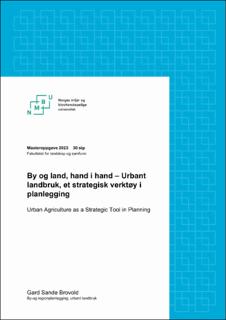| dc.contributor.advisor | Hovedveileder: Kristine Lien Skog | |
| dc.contributor.advisor | Bi veileder: Morten Clemetsen | |
| dc.contributor.author | Brovold, Gard Sande | |
| dc.date.accessioned | 2023-07-18T16:28:36Z | |
| dc.date.available | 2023-07-18T16:28:36Z | |
| dc.date.issued | 2023 | |
| dc.identifier | no.nmbu:wiseflow:6839517:54591651 | |
| dc.identifier.uri | https://hdl.handle.net/11250/3079919 | |
| dc.description.abstract | Lillestrøm kommune befinner seg i og i nærheten av bybåndet som strekker seg fra Asker til Oslo, Ås og Ski til Lillestrøm. Til bybåndet er det forventet en stor befolkningsvekst og som en tiltak for å ta imot befolkningsveksten foregår det en fortettingspolitikk i osloregionen. Lillestrøm kommune innehar store landbruksområder og er en stor kornprodusent på landsbasis. I de regionale planene er Lillestrøm by utpekt som en regional by. Ved å være utpekt som en regional by så er det tilknyttet ekstra vekst, vekst i form av arbeidsplasser og boliger. I en fortetting av bområder er det viktig å lage gode boforhold. Samtidig er det interessant å se om man kan kombinere landbruk og fortetting. Urbant landbruk dukker opp i denne oppgaven og blir satt i sammenheng med kommunal planlegging, byutvikling og landbruksutvikling i Lillestrøm kommune.
I oppgaven så belyses det ulike former for bysamfunn presentert av Herbert Girardet i artikkelen «regenerative cities» (Girardet, 2016), dette relateres til urbant landbruk for å tidlig introdusere aktualiteten av samfunnsomstillingen som kreves for å lage et samfunn for fremtiden. Det er ellers en større teoridel som belyser temaer hvor urbant landbruk begrepet er relevant. Oppgavens problemstillinger går ut på å finne ut hvordan urbant landbruk kan være et strategisk verktøy i planleggingen og hvordan urbant landbruk kan være med på å få til en samfunnsomstilling, en samfunnsomstilling som gir oss et sosialt og miljøvennlig bærekraftig samfunn. I oppgaven er det blitt gjort dokumentstudier, dybdeintervju og en spørreundersøkelse for å kartlegge ulike sider ved urbant landbruk. Spørreundersøkelsen tar for seg både blant annet produsent og konsumenter innen lokalprodusert mat og hvilke motivasjoner og utfordringer disse eventuelt måtte ha. Dokumentstudier av relevante planer og føringer for den kommunale planleggingen skal analyseres i forbindelse med begrepet urbant landbruk. I tillegg er det gjennomført dybdeintervjuer med en planlegger fra kommunen og to fagansvarlige fra landbrukskontoret som skal gi en bedre forståelse av kommunens behandling av urbant landbruk og utformingen og gjennomføringen av kommunale planer. Resultatene viser at urbant landbruk begrepet nevnes ikke i de kommunale planene, dette er også tilfellet for tungtveiende regionale planer. Hvorfor det bedrives salg, produksjon og konsum av lokalprodusert mat i Lillestrøm er ikke kun for økonomisk vinning sin del. For produsentene er det forbundet med sosial omgang og tilhørighet, samtidig som det er en ekstra verdi å kunne produsere noe eget. Konsumentene ga uttrykk for at de syntes lokalmat er noe bedre enn mat som kommer langveisfra og flere poengterer dyrevelferd i den sammenhengen. Lokalprodusert mat ble også vektlagt i forbindelse med klima og miljø. | |
| dc.description.abstract | Lillestrøm municipality is located within the city connection between Asker, Oslo, Ås and Ski to Lillestrøm. This city connection is expected to meet an extensive population growth, to cope with this population growth, national and regional targets and plans have decided a densification in the living areas in the Oslo region. Lillestrøm municipality has large farming areas and is an important farming municipality on a national basis. Lillestrøm city is even chosen as one of the regional cities according to regional plans. Being a regional city there is expected larger growth in population, and therefore a greater densification and a stronger urbanization than other areas. When living areas is densified, there is important to secure enough green spaces to make quality living areas and spaces. When the city and living areas in Lillestrøm grows, farmland will be built upon. In the forming of a greater population in Lillestrø, there is interesting to see if agriculture can be combined with the forming of dense living areas. Urban agriculture comes up as a possible solution to this combination and is put in context together with municipal planning, city, urban development and agricultural development.
In the theory and background, different type of city societies from the article “regenerative cities” by Herbert Girardet (Girardet, 2016), urban agriculture is pointed out as a term in the forming of city societies and Girardets article. This is to point out the need of a change in todays societies to create a sustainable society for the future. The thesis consist of a larger theory and background that further links and investigates urban agriculture in different subjects regarding resilience, agriculture and planning. The problem of the study involves question regarding how urban agriculture can be used as a strategic tool in planning, and also how urban agriculture can contribute to the societal change needed for creating a sustainable society for the future. The thesis consists of a mixed method study research including a survey that investigates motivation and challenges in locally produced food, a literature study analyzing the municipal plans and relevant national and regional plans, and interviews of a municipal land use planner and the municipal agriculture office in Lillestrøm municipality. The results show that urban agriculture is not mentioned in the municipal plans, or even national and regional plans. The results from the survey shows that producing, distributing and consuming locally produced food is not only for economical purposes. For the producers it is highly valued to be a part of a collective “we” and social gathering through activities selling and delivering food and groceries. To meet the consumers first hand is also valued greatly. The consumers in most cases expressed that they thought of locally produced food as something better than food from far locations. Animal welfare was also important to the consumers. | |
| dc.language | nob | |
| dc.publisher | Norwegian University of Life Sciences | |
| dc.title | By og land, hand i hand - Urbant landbruk, et strategisk verktøy i planlegging | |
| dc.type | Master thesis | |
